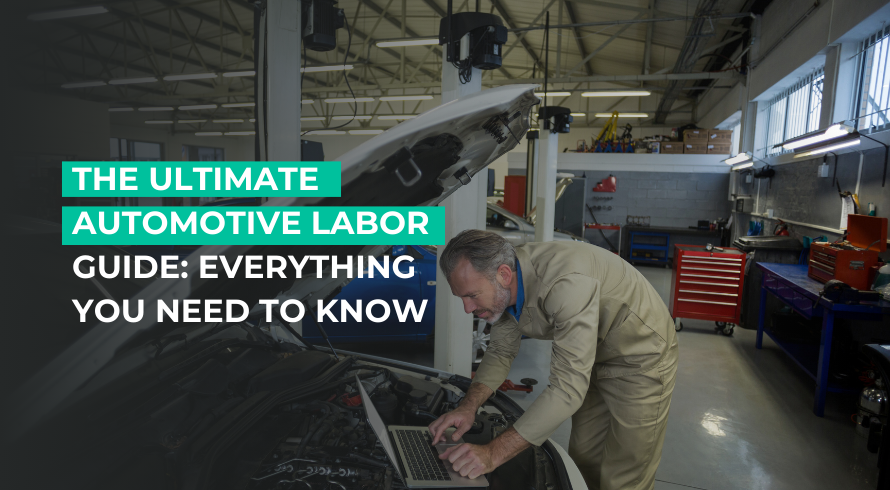Have you ever wondered what goes into calculating the cost of your car repairs? Why do some shops give you one price, and others something totally different? The answer lies in an often-overlooked tool: the automotive labor guide. Whether you’re an auto repair shop owner or a curious customer, understanding labor guides can completely change how you view repair pricing.
What is an automotive labor guide?
An automotive labor guide is a tool used by repair shops to estimate the time it takes to perform specific auto repairs. This guide helps shops provide accurate quotes and ensures labor charges are fair for both the shop and the customer.
Auto repair estimate vs. auto repair quote: What’s the difference?
If you’ve ever been confused about the difference between an estimate and a quote, you’re not alone! Here’s a simple breakdown:
- Auto repair estimate: This is an educated guess based on your vehicle’s condition and the likely cost to fix it. It can change if unexpected issues pop up during the repair.
- Auto repair quote: A fixed price for the job. Once the shop gives you a quote, that’s the amount you’ll pay. It shouldn’t change unless new issues are found that were not included in the original assessment.
For example, let’s say you bring your car in for an oil leak, and the shop gives you an estimate of $200. If they find out your oil pump also needs replacing, the final bill could increase. A quote, on the other hand, would lock in the price unless new, unexpected problems are discovered.
Types of automotive labor guides available
Labor guides aren’t one-size-fits-all. Depending on your shop, vehicle, or personal preference, there are different types to choose from:
1. OEM vs. independent labor guides
- OEM labor guides: These guides come directly from the vehicle manufacturers and are often seen as the most accurate for that particular brand. However, they can sometimes be more expensive to access.
- Independent labor guides: These are created by third-party companies and cover a wide range of vehicle makes and models. While they may not be as brand-specific, they’re often more affordable and flexible.
2. Digital vs. printed labor guides
- Printed labor guides: The traditional method, though they’re becoming less common in today’s digital world. They’re not as up-to-date and are harder to search through.
- Digital Labor Guides: These are the modern solutions, available through automotive labor guide software or apps. They are easily searchable, constantly updated, and can be integrated with shop management software. Plus, some even come with mobile apps, making it easy for mechanics to check estimates on the go.
How to use a labor guide to calculate an auto repair quote
Using a labor guide isn’t just about plugging numbers into a calculator. There’s a method to it, and here’s how you can master it:
- Forecast the necessary materials: Assess the vehicle and figure out what parts will be needed for the job.
- Determine customer pricing: Once you know the parts required, calculate their cost and how much you’ll charge the customer for them.
- Determine labor time: Use the labor guide to find how long the job should take. This is where the guide becomes essential. It tells you how much time each repair task typically takes.
- Set the labor rate: Finally, multiply the time by your shop’s hourly labor rate to get the final labor cost.
Example: If you’re replacing brake pads, the guide might suggest 1.5 hours of labor. Multiply that by your shop’s hourly labor rate, and you’ve got a precise figure for the labor cost.If your hourly labor rate is $100, that’s a $150 labor charge for replacing the brake pads.
Estimating auto repair costs
Creating a detailed and accurate estimate ensures customer satisfaction and trust. Here’s how you can do it using a labor guide:
- Assess the vehicle: Do a thorough check to spot all issues.
- Calculate the cost of damage: Use the guide to determine how long each repair will take.
- Determine tools and parts needed: List everything you’ll need, from parts to specialized tools.
- Create the estimate: Add it all up—parts, labor, and any other fees—and provide the customer with a clear breakdown.
Tips for improving your shop’s margins using labor guides
Labor guides are not just for accuracy—they can also help you boost your shop’s profitability. Here are a few strategies to improve your margins:
1. Establish a labor rate matrix
A labor rate matrix can help you set tiered pricing based on the complexity of the job. Instead of charging a flat hourly rate for every job, create a labor rate matrix. You can charge more for specialized jobs (like engine repairs) and less for simpler tasks (like oil changes). This makes your pricing more competitive and helps you maximize profit where it counts.
2. Use canned services
Canned services are pre-packaged services, like brake jobs or tire rotations, that have a set price. By offering these fixed-price services, you simplify the customer decision-making process and increase the speed at which you complete jobs.
3. Identify factors impacting labor duration
Not every repair is as straightforward as it seems. Maybe a vehicle is in worse shape than expected, or special tools are needed. By identifying these factors ahead of time, you can adjust your estimates and avoid undercharging for longer jobs.
Why software integration with labor guides is a game-changer
One of the biggest trends in auto repair is the integration of labor guides with auto repair shop management software. Here’s why it’s a big deal:
- Saves time: No more flipping through pages or entering data manually. Labor guides integrated with shop software allow you to quickly generate estimates with a few clicks.
- Increases accuracy: By using up-to-date digital labor guides, you ensure that your estimates are accurate and reflect the current labor rates and times.
- Improves customer trust: A clear, precise estimate builds trust with customers, reducing the likelihood of disputes over costs. Utilzing a tool like QuickBooks for auto repair shops also helps to pull up past service data and history to help cater to customers better.
Final thoughts
An automotive labor guide is more than just a tool—it’s a game-changer for auto repair shops. It helps you give fair, accurate estimates, saves you time, and builds customer trust. Plus, with digital tools, it’s easier than ever to integrate labor guides into your day-to-day workflow.
Whether you’re just starting out or you’ve been running a shop for years, mastering the use of a labor guide will help you streamline operations, improve profit margins, and keep your customers happy. So, are you ready to take your shop to the next level?










